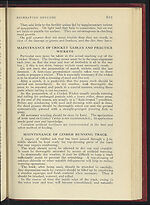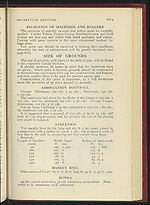1939-40
(696)
Download files
Complete book:
Individual page:
Thumbnail gallery: Grid view | List view

668
RECREATION GAOTJND9
sink slightly. The
part
afTected should be pierced and the in-
equalities made up with fresh topping.
After severe frost the whole surface of the track will rise, as
happens in the case of all water-bound surfaces.
Wait until the frost is out of the ground, then roll down gradually,
a light roller being used in the first instance, then the heavy
roller; squeegee brush, and roll again to a finished surface.
MAIN'T'ENANCE OF HARD GROUNDS
After these grounds become thoroughly weathered and con-
solidated by use, the amount of attention required is small, provided
that this is given regularly, and that the grounds are not neglected
in any way.
The goal areas may become churned up rather deeply at times.
The depressions should not be filled with loose material dragged in
from the adjoining surface, but with new material containing the
proper percentage of fine to bind. A wooden squeegee should be
used to even the area thus treated. The entire surface should then
be matted.
The area should be matted about three times a week, dependent
on the amount of use. This matting can be a piece of coconut mat-
ting measuring about iz ft. square, dragged behind a tractor as
used for snowing, without spikes on the wheels and only when the
ground is firm; otherwise it should be dragged by hand by using
a piece of matting 3 ft. wide and 6 ft. long. Matting which has
become useless for cricket could be made into a suitable drag).
During a spell of dry weather, after matting, the ground should
be thoroughly watered, and about half an hour to an hour allowed
before rolling is carried out, thus allowing the water to soak in..
Rolling should be carried out in an opposite direction on each
occasion, using a petrol driven roller weighing 25 to
30
cwts. (it
should be understood that watering is more essential than rolling
during dry weather). If a roller weighing up to
50
cwts. is the only
one available, this may be used, but with discretion, stopping im-
mediately if it is found to be pushing or cracking the surface, as
more harm than good is being done,
In the event of frost, the area may be played on while the frost
holds, but no games should be played during the period of thaw.
When the frost is out of the material, the area should be rolled before
play is allowed.
Patching, as required, should be carried out by raking the bad
places, well watering, and making up with new material. The
patches should then be thoroughly soaked with water and rolled.
A patch will soon blend in with the remainder of the area.
It is possible that during the winter months, parts of the area may
become too firmly bound and hold water. If the surface is pierced
with a fork, the difficulty will usually be overcome.
Moss will be kept under control by dragging as described.
Weeds, including grass, as they appear should be removed before
seeds form, which would get blown on to the area.
RECREATION GAOTJND9
sink slightly. The
part
afTected should be pierced and the in-
equalities made up with fresh topping.
After severe frost the whole surface of the track will rise, as
happens in the case of all water-bound surfaces.
Wait until the frost is out of the ground, then roll down gradually,
a light roller being used in the first instance, then the heavy
roller; squeegee brush, and roll again to a finished surface.
MAIN'T'ENANCE OF HARD GROUNDS
After these grounds become thoroughly weathered and con-
solidated by use, the amount of attention required is small, provided
that this is given regularly, and that the grounds are not neglected
in any way.
The goal areas may become churned up rather deeply at times.
The depressions should not be filled with loose material dragged in
from the adjoining surface, but with new material containing the
proper percentage of fine to bind. A wooden squeegee should be
used to even the area thus treated. The entire surface should then
be matted.
The area should be matted about three times a week, dependent
on the amount of use. This matting can be a piece of coconut mat-
ting measuring about iz ft. square, dragged behind a tractor as
used for snowing, without spikes on the wheels and only when the
ground is firm; otherwise it should be dragged by hand by using
a piece of matting 3 ft. wide and 6 ft. long. Matting which has
become useless for cricket could be made into a suitable drag).
During a spell of dry weather, after matting, the ground should
be thoroughly watered, and about half an hour to an hour allowed
before rolling is carried out, thus allowing the water to soak in..
Rolling should be carried out in an opposite direction on each
occasion, using a petrol driven roller weighing 25 to
30
cwts. (it
should be understood that watering is more essential than rolling
during dry weather). If a roller weighing up to
50
cwts. is the only
one available, this may be used, but with discretion, stopping im-
mediately if it is found to be pushing or cracking the surface, as
more harm than good is being done,
In the event of frost, the area may be played on while the frost
holds, but no games should be played during the period of thaw.
When the frost is out of the material, the area should be rolled before
play is allowed.
Patching, as required, should be carried out by raking the bad
places, well watering, and making up with new material. The
patches should then be thoroughly soaked with water and rolled.
A patch will soon blend in with the remainder of the area.
It is possible that during the winter months, parts of the area may
become too firmly bound and hold water. If the surface is pierced
with a fork, the difficulty will usually be overcome.
Moss will be kept under control by dragging as described.
Weeds, including grass, as they appear should be removed before
seeds form, which would get blown on to the area.
Set display mode to:
![]() Universal Viewer |
Universal Viewer | ![]() Mirador |
Large image | Transcription
Mirador |
Large image | Transcription
| Games and sports in the army > 1939-40 > (696) |
|---|
| Permanent URL | https://digital.nls.uk/248755248 |
|---|
| Description | 'Games and Sports in the Army' was an annual publication produced by the British War Office between the 1930s and 1960s. This included the Second World War. It outlines the rules and regulations for games and sports played by members of the armed forces. It features names and photographs of team members, and examples of contemporary advertising. |
|---|---|
| Shelfmark | GWB.52 |

